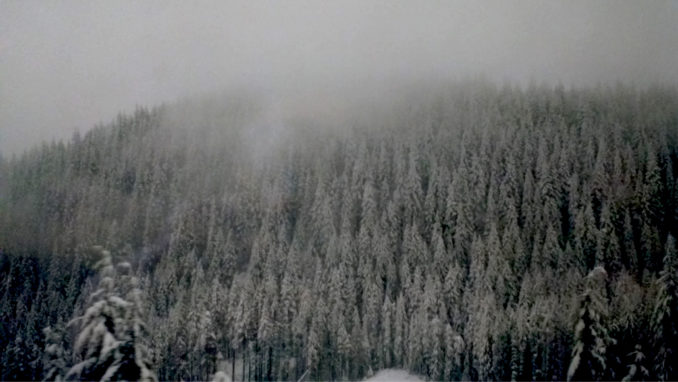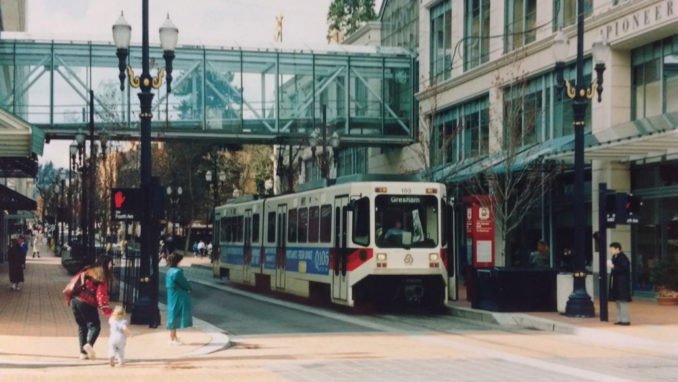
Portland untitled , Tony from PNW – Licence CC BY-SA 2.0
If Chicago is “The Windy City”, New York, “The Big Apple”, New Orleans, “The Big Easy” and Reno, Nevada, “The Biggest Little City in the World”, then Portland, Oregon, is “A Big Retirement Home for the Young”. So suggested Clare Cain Miller in her 2016 New York Times Magazine article entitled, “The Place Where Young People Go to Retire.”
Via a case study which put layabout resident Matthew Hale under the journalistic microscope, Miller concluded that “work is optional” in this “retirement community for the young”. Jobless and car-less, Mathew lived off his barista wife,
“[rather than work] he prefers to walk or ride the bus to the city’s innumerable coffee shops and breweries and live-music spots. On weekends, he and his wife have no problem hitching rides to the Pacific Coast or the Cascade mountain range. Everywhere he looks, Hale told me, there are people just like him — bearded, on skateboards, brewing kombucha. “It’s really chill,” he says.
It is less “chill” four years later, as months of consecutive nights of rioting have seen Federal agents dispatched to the Pacific Northwestern city to protect federal buildings, US monuments and to aid a local police department under siege.
At this point I must confess an interest, although one initially baffled by recent events. Despite being born in a different country, a different continent (and five thousand miles away), both sides of my family have a connection to the area.
In the 1930s, two of my mother’s uncles emigrated to Vancouver, Washington State, which lies on the opposite bank of the mighty Columbia River to Portland. Three centuries previously, paternal ancestors crossed the ocean as early Virginia colonists. They made their money from tobacco and slavery. Easy to trace, their plantations were called after the Cumberland place names that they had left behind. Their descendants crossed the continent as pioneers, some along the Oregon Trail. Unlikely dots on the map hold our unusual Debatable Lands surname on old gravestones and modern phone books.
Following in their footsteps, I lived in the United States three decades ago. Feeling obliged to make a calI, I made it my business to have business in Portland, The Rose City. Much has changed since then. Let’s start with what hasn’t.
Portland, Oregon, is in the wet and misty Pacific Northwest of the United States of America, lying three hundred miles south of Vancouver, British Columbia, two hundred miles south of Seattle and a few hundred yards south of Vancouver, Washington State, on that other river bank. The mighty Columbia runs for twelve hundred miles through the Cascade and Rocky mountains, draining an area the size of France, to the Pacific Ocean at Astoria, eighty miles to the west of Portland.
Oregon, the Beaver state, is sparsely populated. The size of the United Kingdom, it boasts only four million inhabitants, 600,000 of whom live in it’s biggest city, Portland. According to the 2010 census, only 6% of the Rose City’s inhabitants are black, a slight drop since the census of 2000.
Historically, there never was slavery. Somewhat disingenuously, some history books may tell you that anti-black laws were enacted in the 1840s & 50’s.
Before the modern state had been established, the “Territory of Oregon” was itself a debatable land, claimed by the United States, Britain and even Russia. Also covering the modern day states of Washington, Wyoming and Nebraska (and land above the 49th parallel in modern day Canada), the then 10,000 inhabitants, wary of being outnumbered by freed slaves and northern Chinook Native Americans, passed racial residency laws that were unenforceable and quickly rescinded.
For the next century, Oregon’s politics was generally Republican. In the 1952 presidential election, Oregon voted 60%-40% Republican. In 1960 they preferred Nixon to Kennedy but, in 1964, the state swung to the Democrats.
In “Portland in the 1960s: Stories from the Counterculture”, author Polina Olsen writes,
During the 1960s, an influx of hippie subculture began to take root in the city in the wake of San Francisco’s burgeoning countercultural scene.
Of those times, The Oregonian newspaper adds,
The city’s Crystal Ballroom became a hub for the city’s psychedelic culture, while food cooperatives and listener-funded media and radio stations were established. A large social activist presence evolved during this time as well, specifically concerning Native American rights, environmentalist causes, and gay rights. By the 1970s, Portland had well established itself as a progressive city.
For the next twenty years preference in the Presidential elections passed between the two parties. In 1984 Oregon voted for a Republican president (Ronald Reagan) for the last time. Since 1988 the state has called for the Democrats, sometimes by small margins. In 2000, Al Gore carried the state by only seven thousand votes. Portland’s Multnomah county being very liberal, in the 2016 election Clinton received 73% support, Trump 17%.
My time there was at the beginning of that long Democratic run, albeit with a Republican president in the White House, George W. H. Bush.

© Always Worth Saying, Going Postal 2020
Noticeable during the twelve hour train trip along the coast from Sacramento, was the sparsely populated landscape covered with trillions of trees. Upon arrival, Portland presented itself as a working city. Docks and factories sat beneath the watchful presence of a distant snow capped Mount Hood.

© Always Worth Saying, Going Postal 2020
In the city centre, Pioneer Square was pleasant. There were nice people, nice shops and nice places to eat. The area around the railroad station, however, was a skid row of derelict buildings and semi-derelict people, many homeless, exercising a destructive relationship with alcohol and other substances. If there was more to Portland’s progressive counterculture beyond drug abuse, it was subtly done, unobtrusive to those disinterested or not of the demographic.

© Always Worth Saying, Going Postal 2020
Much more evident were environmental concerns. Local news reports told of activists on skis protecting bison from hunters. It was a harsh winter, the beasts were having to forage away from the protection of the national parks. Controversy surrounded the habitat of the northern spotted owl. Chainsaw wrecking metal spikes were being driven into trees in order to hamper the giant local logging industry.
In 1991 a federal court banned the timber industry from public lands in order to protect the owls. In her Mother Jones article “Does anybody give a hoot?” Jeanne Berkow announced this counter-productive.
Ironically, although it reduced timber harvests on Pacific Northwest national forests by 80 percent, the compromise also proved a boon for timber interests: It boosted timber prices and, for a time, companies enjoyed record profits.
Removing parts of Oregon from the supply chain increased the price of timber and encouraged tree felling elsewhere. Meanwhile owl numbers continued to drop.
The logging ban produced an optic attractive to environmentalists and increased Portland’s progressive karma but did nothing for the owls. More of the same was to follow via the obsession with youth’s social mainstream defying counterculture through the “wierd” movement.
In 2000, the Austin (Texas) Independent Business Alliance adopted a “Keep Austin Weird” promotion after a radio station phone-in contribution from local librarian Red Wassenich. The idea was to help local independent businesses to compete against big corporations by marketing them them with unique selling points, difficult for the corporates to match, such as zany, off kilter, eccentric, whimsical, counter-cultural.
This idea found fertile ground in Portland. A “Keep Portland Weird” campaign started with Music Millennium proprietor Terry Currier printing and selling tens of thousands of stickers. Leafing through the Sunday Oregonian reminds us of the likes of the Voodoo Doughnut, the World Naked Bike Ride, the Zoobomb unusual bicycle race, yarn bombing (covering trees in knitted graffiti), the Portland Urban Iditarod (fancy dress shopping trolley racing) , the Museum of Velvet Paintings, the 24 Hour Church of Elvis and much, much more.
Of significance, in her “retirement home” article, Miller describes a current nationwide demographic and cultural shift. As baby boomers retire, she states, many US cities have had to incentivise cheap housing and tax breaks in order to encourage younger people to move there. However, Portland has the opposite problem. There are many highly educated young people but fewer opportunities and lower wages, as per the jobless, drifting Matt Hale of our opening paragraphs.
David Albouy, an economics professor at the University of Illinois, has researched such things. He points out that, traditionally, the estimate of a city’s quality of life has been made through the relationship between its cost of living and wage levels. He has created a new metric, what Miller describes as a “sacrifice measure”, to chart how poor a person is willing to be in order to live in a particular place.
His liveability rankings are broad and even include mild seasons, sunshine, hills and coastal proximity. These are areas in which Portland scores highly, putting the Rose City near the top of his list, despite being 41st out of the 50 largest US cities in terms of earnings.
In the six years since Albouy’s research was published, (and four years since Miller’s article) the virtue signalling non-materialistic attractiveness of “progressive”, “counterculture” and “weird” have been rocket boosted by “woke” and Trump Derangement Syndrome, then sent nuclear by Black Lives Matter and Antifa.
Writing of Portland, Lonely Planet’s Becky Ohlsen says,
“Something about how cheap and isolated Portland is, allows oddballs to explore odd behaviour without being squished by economics or the harsh judgment of fashion people.”

Portland protests day 50, Tony from PNW – Licence CC BY-SA 2.0
The riots in Portland have attracted oddballs from a wide area. Combined with aggressive leftists they have made Portland the way it is today, a violent and inevitable Anti-American consequence of the left-wing sixties counterculture.
Acknowledgements
David Albouy, “Are Big Cities Bad Places To Live? Estimating Quality of Life across Metropolitan Areas.”
Jeanne Berkow. Mother Jones, “Does Anybody Give a Hoot?”
Clare Cain Miller, New York Times Magazine, “The Place Where Young People Go to Retire.”
Polina Olsen, “Portland in the 1960s: Stories from the Counterculture.”
Clare Cain Miller, New York Times Magazine, “The Place Where Young People Go to Retire.”
The Oregonian
The Sunday Oregonian
Wiki
The Goodnight Vienna Audio file



